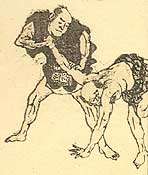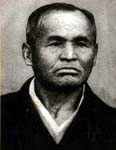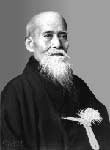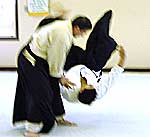Jujutsu: The Evolving Art
Part 3 - Unarmed Jujutsu Systems, Daito Ryu & Aikido
By Tom Ross & Christopher Caile
 During
the peaceful Tokugawa(1600-1868) period, when Japan had been unified under
a single and powerful military power, amour was not commonly worn and
internal warfare had ceased. Need arose for minimally armed and unarmed
techniques and numerous self-defense oriented jujutsu systems developed,
many by warriors. During
the peaceful Tokugawa(1600-1868) period, when Japan had been unified under
a single and powerful military power, amour was not commonly worn and
internal warfare had ceased. Need arose for minimally armed and unarmed
techniques and numerous self-defense oriented jujutsu systems developed,
many by warriors.
It was also during this period that some systems began to emphasize self
perfection, ethical and spiritual goals over combat efficiency (the beginning
of "do" forms of various combat systems).
 Instruction
was not generally open to the public, and candidates were strictly scrutinized.
Candidates who were accepted frequently were required to take a "Keppan"
(blood oath) that they would not divulge the secrets of the system. This
practice combined with the lack of a sense of necessity (warfare) led
to a further decline in practice of many jujutsu and other classical weapon
arts. In some instances skilled jujutsu practitioners, who no longer were
able to make ends meet due to a lack of students, were forced to perform
sideshow-like demonstrations, taking on all challengers for money. Jujutsu
began to lose its prestige and came to be looked upon by many as an activity
for ruffians and troublemakers. Instruction
was not generally open to the public, and candidates were strictly scrutinized.
Candidates who were accepted frequently were required to take a "Keppan"
(blood oath) that they would not divulge the secrets of the system. This
practice combined with the lack of a sense of necessity (warfare) led
to a further decline in practice of many jujutsu and other classical weapon
arts. In some instances skilled jujutsu practitioners, who no longer were
able to make ends meet due to a lack of students, were forced to perform
sideshow-like demonstrations, taking on all challengers for money. Jujutsu
began to lose its prestige and came to be looked upon by many as an activity
for ruffians and troublemakers.
The Ancient Tradition of Daito Ryu
As Japan emerged into the modern age countless weapon and jujutsu systems
died with their teachers. Having developed and prospered in the feudal
ages, a modern Japan infused with western technology and armament, had
little need for these ancient systems and skills.
Many systems did survive, however. One such system, Daito Ryu had been
preserved and practiced within a secret family tradition for centuries
and has become a popular classical tradition. Daito ryu has also inspired
many secondary systems, known under the heading aiki jujutsu, that developed
from it. Daito ryu is also the primary source and inspiration for another
derivative art, one that has become known the world over as aikido.
Daito ryu's existence also indicates that not all early jujutsu systems
existed merely as an adjunct to weapon arts. While its techniques certainly
were useful in countering a sword welding battlefield opponent (empty
handed), daito ryu's techniques comprised a separate system of self-defense.
It was also oriented to non-battlefield situations, as when warriors,
in camp, or in other situations when dressed in light armor (or regular
warrior attire and often carrying only a knife), needed to deal with empty
hand and weapon attacks (including knives and swords). The existence of
this art, however, was not known to the public until comparably recently.
 Then,
stepping from the mist of history, as if a man out of place and time,
came Sokaku Takeda. Born October 10, 1859 at the Takeda Mansion in Oike,
Aizubange cho (modern day Fukushima Prefecture) into an established family
with a long Samurai tradition, Sokaku had the benefit of learning the
various Aizu clan's weapon systems as well as its secret empty hand methods
(thought to be first developed by Shinra Saburo no Minamoto during his
lifetime 1045-1127, although many techniques used in the art are thought
to have been in existence for some time) that had developed over centuries
as self-defense. Then,
stepping from the mist of history, as if a man out of place and time,
came Sokaku Takeda. Born October 10, 1859 at the Takeda Mansion in Oike,
Aizubange cho (modern day Fukushima Prefecture) into an established family
with a long Samurai tradition, Sokaku had the benefit of learning the
various Aizu clan's weapon systems as well as its secret empty hand methods
(thought to be first developed by Shinra Saburo no Minamoto during his
lifetime 1045-1127, although many techniques used in the art are thought
to have been in existence for some time) that had developed over centuries
as self-defense.
Although many theories exist as to why Takeda decided to come forward
and begin teaching this formerly private system, it is generally regarded
as having been due to the urging of Sokaku's mentor, one Chikanori Hoshina
(known prior to changing his name as Tanomo Saigo) who reputedly advised
young Sokaku that times had changed, and that he should go forth and teach
acceptable candidates in order to prevent the loss of the family system.
Sokaku is thus not regarded as the founder of Daito ryu but rather the
"Chuko no so," meaning the "reviver" of Daito ryu.
Although Takeda was not much known outside of Japan (leading many to
make false claims of having trained directly under him), he is amongst
the most written about and documented of martial arts masters. He kept
a series of ledgers not only documenting who he taught, but what he taught
to whom and how much they paid for instruction. Takeda was a vigorous
instructor who taught many of Japan's political elite as well as military
and law enforcement officials. In 1910 Takeda traveled to Hokkaido (a
northern Island of Japan) as an escort for a Police Chief newly transferred
to the inhospitable area.
It was around 1922 that Takeda first began referring to his teachings
as "Daito ryu Aikijujutsu." Prior to this time, he merely referred
to Daito ryu as a system of jujutsu, as evidenced by his early ledgers
which contain such notations as "Daitoryu Jujutsu Hombu cho"
(Daito ryu Jujutsu Director of headquarters).
Although many theories exist as to why this was done, one can readily
assume Takeda sought to differentiate his system from others by including
the Aiki prefix. Borrowing from the book known as the Jujutsu Kyoju sho
Ryu no maki (text of jujutsu volume on Ryu), we have an excellent definition:
"Aiki is an impassive state of mind without a blind side, slackness,
evil intention or fear. There is no difference between Aiki and Ki ai,
however if compared, when expressed dynamically Aiki is called Ki ai,
and when expressed satically it is called Aiki."
What distinguished the art, however, was the breath of its inventory
and subtlety of technique developed over centuries of refinement. Technique
did not stress strength but rather use of one's weight and center as well
as internal energy.
|
|
|
Here a modern exponent of Daito Ryu practices an
empty hand stop of a downward sword cut. The sword's cut is interrupted
then redirected to the side. If this was a real attack, the defender
would counter by breaking the attackers elbow, and then follow with
a kick to the ribs and finally when the attacker was taken to the
ground, a finishing knife hand strike to the head.
|
Daito Ryu's Modern Jujutsu Derivitive: Aikido
 It
is in his ledger in February of 1915 where we see the entry of one Morihei
Uyeshiba who participated in a ten day seminar in Diato ryu given by Takeda
at the Hisada Inn in Engaru. Uyeshiba quickly became a devoted student
of Tekada and his name immediately appears again in two subsequent ten
day seminars. In 1916, Uyeshiba, then residing in Shirataki, had a house
built near his instructor and shortly thereafter Uyeshiba sent for his
family and resided there from that time on. Uyeshiba departed, however,
in December of 1919 upon the illness of his father, and he gave his home
in Shirataki to his teacher. Uyeshiba, himself a talented martial artist,
became involved with the Omotokyo religious sect settling in Ayabe near
Kyoto. In September of 1922 Sokaku Takeda visited Uyeshiba there awarding
him a Kyoju Dairi (a teaching representative certificate) after a further
five months of study. (2) It
is in his ledger in February of 1915 where we see the entry of one Morihei
Uyeshiba who participated in a ten day seminar in Diato ryu given by Takeda
at the Hisada Inn in Engaru. Uyeshiba quickly became a devoted student
of Tekada and his name immediately appears again in two subsequent ten
day seminars. In 1916, Uyeshiba, then residing in Shirataki, had a house
built near his instructor and shortly thereafter Uyeshiba sent for his
family and resided there from that time on. Uyeshiba departed, however,
in December of 1919 upon the illness of his father, and he gave his home
in Shirataki to his teacher. Uyeshiba, himself a talented martial artist,
became involved with the Omotokyo religious sect settling in Ayabe near
Kyoto. In September of 1922 Sokaku Takeda visited Uyeshiba there awarding
him a Kyoju Dairi (a teaching representative certificate) after a further
five months of study. (2)
Uyeshiba, however, began to branch off, adapting the techniques he had
learned from his teacher to fit the moral and philosophical idea's he
had developed as a member of the Omotokyo. At first he called his new
art Aiki Budo but this was later changed to Aikido. There is some speculation,
based on the patterns of movement (circular, pivoting and turning), that
Uyeshiba may have been influenced by Chinese Pa kua (an internal kung
fu system stressing circular foot movements and technique) while having
been in Manchuria with Onisaburo Deguchi (leader of the Omoto kyo sect).
There is, however, no direct documentation to support this theory.
 In
any event, the aikido that emerged was much less linear than daito ryu
and included powerful spinning and turning techniques. And while the number
of total individual techniques was reduced, those retained were made more
universally applicable, and modified not to cause physical damage, only
momentary pain. In
any event, the aikido that emerged was much less linear than daito ryu
and included powerful spinning and turning techniques. And while the number
of total individual techniques was reduced, those retained were made more
universally applicable, and modified not to cause physical damage, only
momentary pain.
Sokaku Takeda died on April 25, 1943 after naming his son Tokimune, heir
to the system. Today, however, several competing systems lay claim to
this system of traditional techniques. Many other aikijujutsu systems
have also developed since that time each influenced by the diato ryu tradition.
Over the following years, Morihei Uyeshiba promoted his new art and
even brought it to foreign shores, attracting millions of adherents to
his "Aikido.' With his death in 1969, the art fragmented into schools
with varying emphasis on technique, ki (internal energy) and philosophy
of engagement.
Although both Takeda and Uyeshiba did a tremendous amount in the promotion
of their respected systems, we can not fail to mention the work of a man
who preceded Takeda by some eighteen years, Jigoro Kano. See the next
installment of this series.
(2) Aikido sources say that their founder had
received a Menkyo Kaidan from Takeda, the highest certificate of achievement
indicating that he had achieved full mastery of the Daito Ryu system.
|